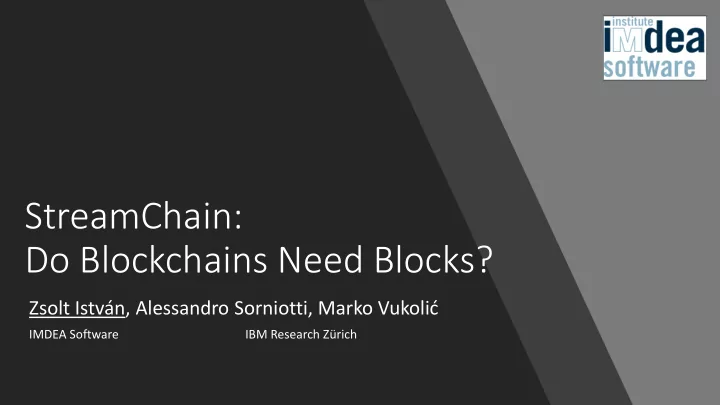

StreamChain: Do Blockchains Need Blocks? Zsolt István, Alessandro Sorniotti , Marko Vukolić IMDEA Software IBM Research Zürich
StreamChain in a nutshell • Goal : Low latency and high throughput operation in permissioned ledgers for wider adoption (without changing security or reliability properties) • Idea : Revisit core design decisions → turn block-based processing into streaming processing • Enables : New opportunities for blockchains, ability to benefit from recent hardware trends 2
The lineage of permissioned ledgers • Public ledgers (blockchains) • Permissioned ledgers • Geo-distribution → no way around • Compelling non geo-distributed communication latency, gossip to use-cases keep everyone up to date • Low latency, high bandwidth, gossip not necessary • Proof-of-work → amortize cost by • No proof-of-work packaging up many TXs in blocks Pain point: When executed inside the same datacenter, permissioned ledgers still take hundreds of milliseconds 3 for transaction finality!
The source of high latency Extra latency T T T T T T T T T Input: 0 1 2 3 4 5 6 7 8 Compute Compute: hash + Sign S T T T T T T T T T I Output: 0 1 2 3 4 5 6 7 8 G time a) “Block” behavior T T T T T T T T T Input: 0 1 2 3 4 5 6 7 8 Compute: Compute hash + Sign S T T T T T T T T T I Output: 0 1 2 3 4 5 6 7 8 G time 4 b) Streaming behavior
StreamChain – Design principles • Process transactions system-wide as they arrive • Reduces latency without impacting throughput • Use batching to hide the cost of high-latency operations (disk accesses) • Logical “blocking” of transactions and batching are decoupled • Use multi-core parallelism to speed up cryptographic operations • Streaming doesn’t change the cost of these… 5
Hyperledger Fabric 101 • Open source platform for building applications on top of a permissioned ledger • Smart contracts as “chain code” written in various languages • Customizable behavior • Separates ordering of transactions into dedicated service – pluggable implementations for BFT CC Peer Ord. Peer Ord. Ord. Peer 6
Executing transactions in Fabric • Has an EOV model to save resources, provide confidentiality • Execute : Choice of endorsers depends on a user’s endorsement policy and produce R/W set of the TX • Order : Orderer orders the transactions (R/W sets signed by endorsers), signs blocks • Validate : Nodes apply R/W set if endorsement is valid and compatible with state CC R/W Ordering CC State KVS Peer Peer R/W Peer R/W Ledger Peer 7
Life after Ordering in Fabric • Fabric can have failed transactions due to R/W set conflicts CC 3 • Client have to retry transaction CC 2 CC • (Or use a suitable programming model) State KVS Peer • The less latency between execution and 100ms validation, the less chance of failing TX R/W Ledger • StreamChain brings this additional benefit in Fabric 8
Sketch of StreamChain in Fabric Endorsement of chain codes Pipelined execution of Validate step R/W Set Write to Sign. Valid. Validation Ledger TXs from Orderer Peer S L Batching Streaming Streaming 9
Our Proof of Concept • Modifies Fabric v1.0 code to simulate behavior • Streaming by making blocks with 1 TX and null signatures from CFT ordering service • Still relies on TLS connections • Cost of Orderer signature checking per block is negligible compared to TX signatures • Implemented parallel signature checks on TXs in the peers • Simulating amortized cost of disk access using RAMdisk 10
Does this work with ordering service failures? • For CFT: Connections to ordering nodes set up via TLS • Can rely on single ordering node until crash • For BFT: If each node connects to t+1 ordering nodes: data can be streamed from one, hashes from the others • High bandwidth requirement, many connections # TX # 11
Does this work with a BFT ordering service? • If connecting to only one ordering node, transactions cannot be recorded to ledger as they arrive • Multi-signature required periodically • Can speculate on state in the meantime – explained in the paper • Make transaction outcome immediately visible to execution logic • If signature is wrong, remove temporary state • May waste work but no data corruption possible on ledger 12
Evaluation • Ran StreamChain in the IBM Cloud (9 machines) • Intel Xeon E5-2683 @ 2GHz • SSD storage • 1Gbps network • Compared to Fabric (Fabcoin) [Eurosys18] • UTXO application • ~4000TX/s, ~350ms end-to-end latency • (Related work has similar orders of magnitude) 13
Latency 14
Throughput vs Latency Throughput bound by R/W set 140 check and ledger commit. Committing Logic Latency (ms) 120 Fabric (Fabcoin) 100 80 60 Future expectation 40 StreamChain P.o.C. 20 0 0 1000 2000 3000 4000 Throughput (TX/s) 15
Thoughts on the future • Permissioned ledger adoption could hinge on performance • Revisit assumptions: streaming processing is a realistic option • Proof-of-concept using Hyperledger Fabric • StreamChain exposes new bottlenecks → New research challenges • Ordering service optimizations • Smart contract execution Birds of a Feather Session tomorrow: Consensus and coordination using modern hardware 16
Recommend
More recommend